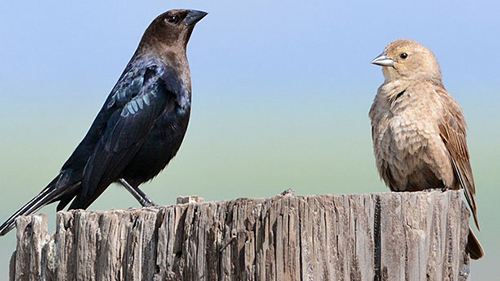Cowbirds Practicing Brood Parasitism on NIEHS Campus
By Bill Willis
July 31, 2017

A Brown-headed Cowbird couple (a male on the left, female on the right).
(Photo courtesy of Sterling Moore)
Found throughout the south and eastern United States, the Brown-headed cowbird (Molothrus ater), is known to lay eggs in the nests of unsuspecting song birds, a practice called brood parasitism that changes the dynamics of raising baby chicks. This practice is widespread in North Carolina and has happened to a Carolina Wren on our NIEHS campus. Other birds may soon be impacted.
The female cowbird can lay up to forty eggs in a season and any one of 220 host species of birds could receive a single egg. The unfamiliar speckled egg usually goes undetected by the host mother even though it might not resemble the other eggs in color or size. A few species will identify the intruder, and remove the egg or abandon the nest. However, studies show that more than 140 host species will raise the alien chick as one of their own. If the cowbird returns to the host nest to check on her egg and it's not there, she may destroy the nest to ensure that it's rebuilt, she is able to deposit another egg.
Raising Unfamiliar Young
If the cowbird egg isn't removed, then it will usually hatch before the native eggs. This gives the alien chick a size and consumption advantage over the host's own young, often leading to the host's own young dying. The cowbird eggs take about 10 days to hatch; a chick will be fully feathered and ready to fly after 8-13 days, but stays around the nest to be fed by its host for another couple of weeks.
Intervention Isn't Common
Intervention by humans isn't recommended unless there is a severe impact on an endangered species. The 1918 Migratory Bird Act protects both the native Carolina Wren and the Brown-headed cowbird. Nests can be observed, but should not be disturbed. Eastern Bluebirds, Carolina Chickadees, Carolina Wrens, Brown-headed Nuthatch, and the Titmouse all use campus nest boxes. If the box has at least a 1.5 inch opening, that nest could be subject to brood parasitism by the cowbird.
For further information, check out the photos below.

A Carolina Wren selected a lifesaver ring by Discovery Lake to begin building their nest
(Photo courtesy of Bill Willis)

A Carolina Wren nest takes shape in a Life Guard Station
(Photo courtesy of Bill Willis)

After a couple of days, five eggs are present in the Carolina Wren nest. The top one looks different from the other four, and it's likely a Cowbird egg
(Photo courtesy of Bill Willis)

The mother Carolina Wren sits on all the eggs
(Photo courtesy of Bill Willis)

Only one of the eggs has hatched and the chick is growing fast
(Photo courtesy of Bill Willis)

Several days later, three more chicks hatch. The new chicks are a fraction of the size of Cowbird. Pink mouth is of the first born, yellow for the later chicks
(Photo courtesy of Bill Willis)

Feeding time is forever
(Photo courtesy of Bill Willis)

As the chicks continue to grow, the cowbird chick grow much larger and barely fits in the nest. Soon it would leave the nest, having been successfully fed by the Carolina Wren
(Photo courtesy of Bill Willis)



